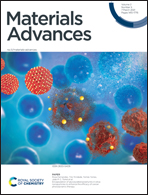Methylene- and thioether-linked cyanobiphenyl-based liquid crystal dimers CBnSCB exhibiting room temperature twist-bend nematic phases and glasses†
Abstract
The twist-bend nematic (NTB) phase is a new heliconical liquid crystal (LC) phase that is associated with spontaneous symmetry breaking for achiral bent LC molecules. Herein, we demonstrate a homologous series of LC dimers exhibiting the stable NTB phases, which undergo vitrification to give NTB glass (NTBG) phases upon cooling below room temperature. Methylene- and thioether-linked cyanobiphenyl-based LC dimer homologs, i.e., CBnSCB (carbon number of the central oligomethylene spacer, n = 2, 4, 6, 8, and 10, for a bent molecular geometry) were developed for the first time. The phase-transition behavior and phase characteristics of CBnSCB were investigated by polarized light optical microscopy (POM), differential scanning calorimetry (DSC), and X-ray diffractometry (XRD). All CBnSCB homologs were found to be mesogenic, wherein CBnSCB (n = 4, 6, 8, and 10) exhibited NTB phases below the temperatures of conventional nematic (N) phases. Additionally, CB2SCB, which possesses the shortest spacer, showed a kinetically induced, monotropic mesophase that was formed directly from the isotropic (I) phase with a strong first order phase-transition property. Although POM observations of CB2SCB revealed the presence of optical textures similar to modulated N or pseudo-layered NTB phases, the XRD results indicated its apparently non-layered and liquid-like nature. In addition, the mesophase of CB2SCB was assumed to be miscible with the NTB phase of CB4SCB. It was therefore suggested that CB2SCB exhibited a NTB phase formed directly from the I phase. It is noteworthy that the NTB phases of CBnSCB (n = 2, 4, 6, and 8) underwent vitrification upon supercooling below room temperature, giving the NTBG phases. In particular, CBnSCB (n = 6 and 8) exhibited remarkably stable NTB and N phases, undergoing no crystallization upon re-heating from the NTBG phase up to the I phase. Furthermore, we investigated the phase-transition behaviors of previously reported analogs, i.e., bis(thioether)-linked CBSnSCB and ether- and thioether-linked CBOnSCB LC dimers (odd numbered n = 3, 5, 7, 9, and 11, for a bent geometry) using POM, and observed NTB phase formation from the small supercooled N domains of CBS11SCB, CBO3SCB, and CBO11SCB. It was therefore indicated that all reported bent CBSnSCB and CBOnSCB dimers (n = 3, 5, 7, 9, and 11) form the NTB phase. It was found that the CBnSCB homologs exhibited remarkably stable NTB phases and vitrifiable tendencies compared with the previously reported CBSnSCB and CBOnSCB analogs.



 Please wait while we load your content...
Please wait while we load your content...